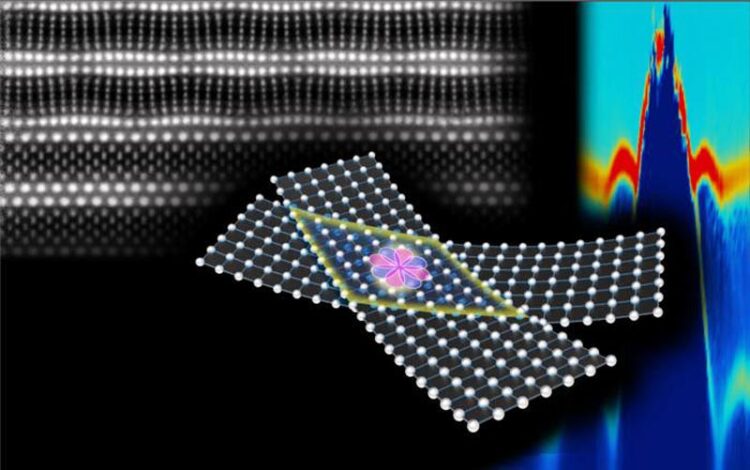High-temperature superconductors, with a twist?

Graphical representation of the stacked, twisted cuprate superconductor, with accompanying data in the background.
Credit: Lucy Yip, Yoshi Saito, Alex Cui, Frank Zhao
Fabrication method could facilitate materials discovery.
Superconductors have intrigued physicists for decades. But these materials, which allow the perfect, lossless flow of electrons, usually only exhibit this quantum-mechanical peculiarity at temperatures so low – a few degrees above absolute zero – as to render them impractical.
A research team led by Harvard Professor of Physics and Applied Physics Philip Kim has demonstrated a new strategy for making and manipulating a widely studied class of higher-temperature superconductors, called cuprates, clearing a path to engineering new, unusual forms of superconductivity in previously unattainable materials.
Using a uniquely low-temperature device fabrication method, Kim and his team report in the journal Science a promising candidate for the world’s first high-temperature, superconducting diode – essentially, a switch that makes current flow in one direction – made out of thin cuprate crystals. Such a device could theoretically fuel fledging industries like quantum computing, which rely on fleeting mechanical phenomena that are difficult to sustain.
“High-temperature superconducting diodes are, in fact, possible, without application of magnetic fields, and open new doors of inquiry toward exotic materials study,” Kim said.
Cuprates are copper oxides that, decades ago, upended the physics world by showing they become superconducting at much higher temperatures than theorists had thought possible, “higher” being a relative term (the current record for a cuprate superconductor is -225 Fahrenheit). But handling these materials without destroying their superconducting phases is extremely complex due to their intricate electronic and structural features.
The team’s experiments were led by S. Y. Frank Zhao, a former student in the Griffin Graduate School of Arts and Sciences and now a postdoctoral researcher at MIT. Using an air-free, cryogenic crystal manipulation method in ultrapure argon, Zhao engineered a clean interface between two extremely thin layers of the cuprate bismuth strontium calcium copper oxide, nicknamed BSCCO (“bisco”). BSCCO is considered a “high-temperature” superconductor because it starts superconducting at about -288 Fahrenheit – very cold by practical standards, but astonishingly high among superconductors, which typically must be cooled to about -400.
Zhao first split the BSCCO into two layers, each one-thousandth the width of a human hair. Then, at -130, he stacked the two layers at a 45-degree twist, like an ice cream sandwich with askew wafers, retaining superconductivity at the fragile interface.
The team discovered that the maximum supercurrent that can pass without resistance through the interface is different depending on the current’s direction. Crucially, the team also demonstrated electronic control over the interfacial quantum state by reversing this polarity. This control was what effectively allowed them to make a switchable, high-temperature superconducting diode – a demonstration of foundational physics that could one day be incorporated into a piece of computing technology, such as a quantum bit.
“This is a starting point in investigating topological phases, featuring quantum states protected from imperfections,” Zhao said.
The Harvard team worked with colleagues Marcel Franz at University of British Columbia and Jed Pixley at Rutgers University, whose teams previously performed theoretical calculations that accurately predicted the behavior of the cuprate superconductor in a wide range of twist angles. Reconciling the experimental observations also required new theory developments, performed by University of Connecticut’s Pavel A. Volkov.
The research was supported, in part, by the National Science Foundation, the Department of Defense, and the Department of Energy.
Journal: Science
DOI: 10.1126/science.abl8371
Method of Research: Experimental study
Subject of Research: Not applicable
Article Title: Time-reversal symmetry breaking superconductivity between twisted cuprate superconductors
Article Publication Date: 7-Dec-2023
Media Contact
Anne Manning
Harvard University
anne_manning@harvard.edu
Original Source
https://www.science.org/doi/abs/10.1126/science.abl8371?af=R
All latest news from the category: Physics and Astronomy
This area deals with the fundamental laws and building blocks of nature and how they interact, the properties and the behavior of matter, and research into space and time and their structures.
innovations-report provides in-depth reports and articles on subjects such as astrophysics, laser technologies, nuclear, quantum, particle and solid-state physics, nanotechnologies, planetary research and findings (Mars, Venus) and developments related to the Hubble Telescope.
Newest articles

Properties of new materials for microchips
… can now be measured well. Reseachers of Delft University of Technology demonstrated measuring performance properties of ultrathin silicon membranes. Making ever smaller and more powerful chips requires new ultrathin…

Floating solar’s potential
… to support sustainable development by addressing climate, water, and energy goals holistically. A new study published this week in Nature Energy raises the potential for floating solar photovoltaics (FPV)…

Skyrmions move at record speeds
… a step towards the computing of the future. An international research team led by scientists from the CNRS1 has discovered that the magnetic nanobubbles2 known as skyrmions can be…





















